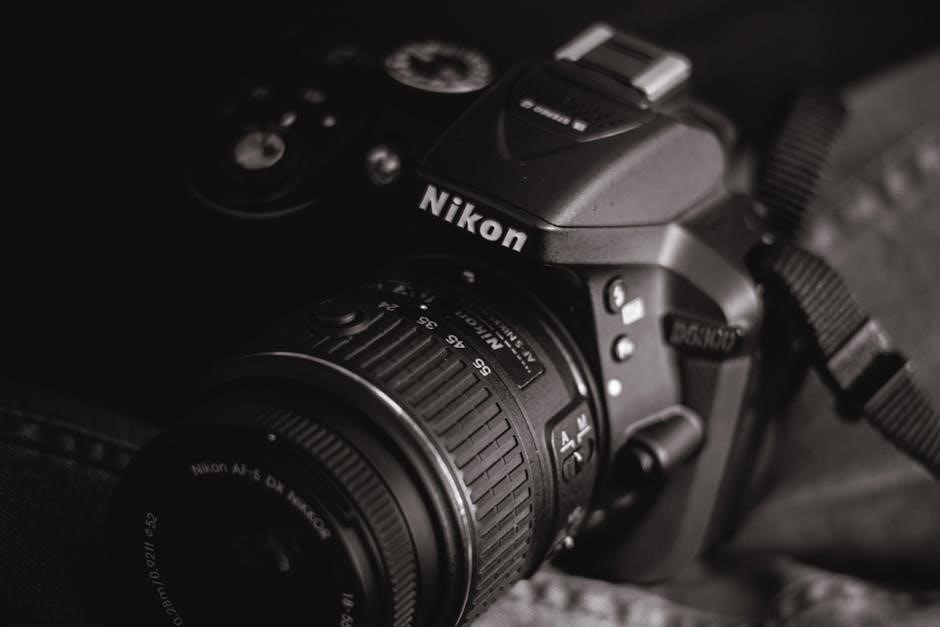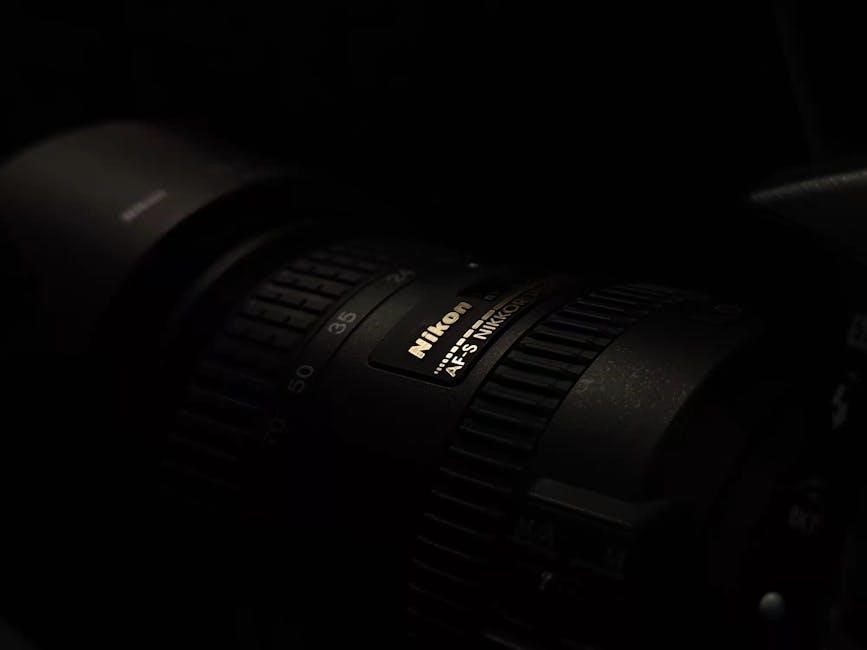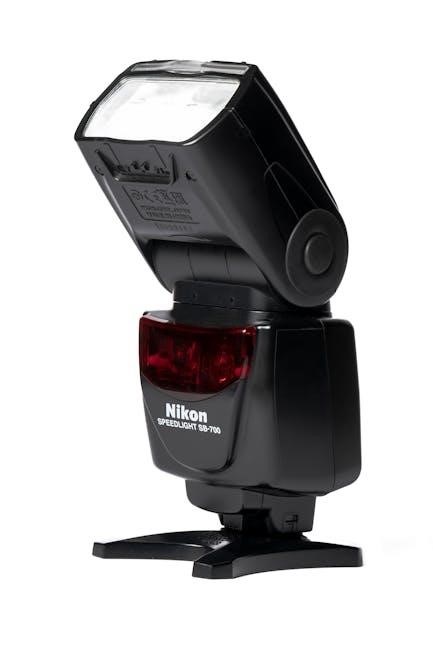nikon d200 manual
Welcome to the Nikon D200 manual, your comprehensive guide to mastering this mid-range DSLR․ Discover its 10․2 MP sensor, 2․5-inch LCD, and advanced shooting modes for professional-grade photography․
Overview of the Nikon D200
The Nikon D200 is a mid-range digital SLR camera designed for professional-grade photography․ It features a 10․2-megapixel CCD sensor, a 2․5-inch LCD display, and an 11-point autofocus system․ Known for its durability and ergonomic design, the D200 supports various lenses and accessories, making it versatile for both enthusiasts and professionals․ Its robust performance and advanced features ensure high-quality images, catering to a wide range of photographic needs and preferences․
History and Development of the Nikon D200
The Nikon D200 was released in 2005, succeeding the D100․ It featured a 10․2-megapixel CCD sensor, a significant upgrade, and incorporated advanced features from the professional D2X․ This mid-range DSLR bridged the gap between enthusiast and professional cameras, offering robust performance and durability․ Its development marked a leap in Nikon’s DSLR technology, making it a favorite among photography enthusiasts and professionals alike for its balance of quality and accessibility․
Key Features and Specifications
The Nikon D200 boasts a 10․2-megapixel CCD sensor, 2․5-inch LCD, and 11-point autofocus system․ It offers an ISO range of 100-3200, ensuring versatility in various lighting conditions, and features a durable magnesium alloy body for professional use․ Its advanced shooting modes and customizable controls make it a powerful tool for photographers seeking high-quality results․
10․2 Megapixel CCD Sensor
The Nikon D200 is equipped with a high-performance 10․2-megapixel CCD sensor, designed to deliver exceptional image quality․ This sensor captures intricate details, ensuring rich colors and excellent contrast․ It provides a maximum resolution of 3872 x 2592 pixels, ideal for producing large prints or cropping images without losing clarity․ The CCD technology excels in color accuracy and dynamic range, making it a reliable choice for photographers seeking professional-grade results in various lighting conditions․
2․5-Inch LCD Display
The Nikon D200 features a 2․5-inch LCD display, providing a clear and convenient way to review images and adjust camera settings․ This screen allows photographers to instantly assess their shots, ensuring proper composition and exposure․ Its size and clarity make it ideal for on-the-spot evaluations, helping to refine techniques and capture better photos without the need for external devices․
11-Point Autofocus System
The Nikon D200 is equipped with an advanced 11-point autofocus system, designed for precise and rapid subject tracking․ This system offers multiple focus modes, including single-point AF, dynamic-area AF, and 3D-tracking AF, enabling photographers to capture sharp images with ease․ Its versatility and speed make it ideal for both stationary and moving subjects, ensuring accurate focus in various shooting conditions․
ISO Sensitivity Range (100-3200)
The Nikon D200 features an ISO sensitivity range of 100 to 3200, offering flexibility for various lighting conditions․ Lower ISO settings (100-400) are ideal for bright environments, minimizing noise for crisp images․ Higher ISOs (800-3200) enable shooting in low light, though noise may increase․ This range provides a balance between image quality and versatility, allowing photographers to capture sharp, detailed photos in diverse situations without compromising on performance․

Getting Started with the Nikon D200
Begin your journey with the Nikon D200 by unboxing and setting up your camera․ Follow the initial configuration steps to familiarize yourself with the controls and basic operations, ensuring a smooth start to mastering your DSLR․
Unboxing and Initial Setup
Upon unboxing the Nikon D200, you’ll find the camera body, battery, charger, and neck strap․ Insert the battery and charge it fully before use․ Install a compatible CF or MicroDrive memory card, ensuring it’s formatted in the camera․ Power on the camera and navigate to the setup menu to configure date, time, and language․ Familiarize yourself with the camera’s controls and refer to the manual for detailed setup instructions to get started seamlessly․
First-Time Camera Configuration
When configuring the Nikon D200 for the first time, set the image quality to your preferred format (JPEG, RAW, or TIFF)․ Adjust the white balance to match lighting conditions and select the appropriate autofocus mode․ Set the ISO sensitivity within the 100-3200 range for optimal results․ Refer to the manual for guidance on customizing settings to suit your photography style and ensure everything is properly calibrated before capturing images․
Basic Camera Operations
Mastering the Nikon D200’s basic operations is essential for capturing stunning images․ Adjust exposure compensation using the /- button and main command dial․ Select autofocus modes with the AF button and sub-command dial․ Use the Info button to set the self-timer and configure shooting settings․ Press the WB button to cycle through white balance options․ Format your memory card via the menu for a fresh start․

Understanding the Camera Controls
The Nikon D200 features intuitive controls, including external buttons for autofocus, white balance, and exposure adjustments․ Its customizable functions and logical layout enhance shooting efficiency and personalization․
External Controls and Buttons
The Nikon D200 features a range of external controls designed for quick access to essential functions․ The mode dial on top allows easy switching between shooting modes, while the AF button enables autofocus adjustments․ The WB button near the top left facilitates white balance changes․ Command dials on the front and rear provide intuitive control over aperture and shutter speed․ These buttons are strategically placed for efficient operation, ensuring seamless adjustments during shooting sessions․
Customizable Buttons and Functions
The Nikon D200 offers customizable buttons to enhance shooting efficiency․ The AF button can be programmed for autofocus modes, while the WB button allows quick white balance adjustments․ Command dials can be configured to control aperture or shutter speed, streamlining workflow․ These customization options enable photographers to tailor the camera to their preferences, improving responsiveness and personalizing the shooting experience for optimal results․ This flexibility is a standout feature of the D200․

Shooting Modes and Techniques
Explore the Nikon D200’s versatile shooting modes, including Auto, P, S, A, and M, offering flexibility for various photography styles․ Advanced techniques like continuous AF and bracketing enhance creativity and precision, ensuring optimal results in diverse lighting conditions and scenarios․
Auto, P, S, A, M Modes
The Nikon D200 offers five primary shooting modes: Auto, Program (P), Shutter Priority (S), Aperture Priority (A), and Manual (M)․ Auto mode simplifies photography by automatically adjusting settings․ Program mode offers customization while maintaining balanced exposure․ Shutter Priority (S) allows control over shutter speed to freeze or blur motion․ Aperture Priority (A) enables adjustment of the aperture for depth of field control․ Manual (M) mode provides full creative control over both shutter and aperture settings, ideal for advanced photographers seeking precise results․
Advanced Shooting Techniques
Advanced techniques with the Nikon D200 include bracketing for exposure, burst mode for rapid shooting, and RAW format for enhanced image editing․ Custom functions allow personalized settings, while AF fine-tuning ensures precise focus․ Utilize dynamic autofocus modes for tracking moving subjects and explore white balance adjustments for accurate color representation․ These features empower photographers to capture professional-grade images with precision and creativity, making the D200 a versatile tool for mastering advanced photography techniques․
Custom Settings and Personalization
The Nikon D200 offers extensive customization options, allowing users to tailor settings like white balance, noise reduction, and autofocus modes to their preferences․ Personalize your shooting experience with adjustable buttons and menu options to optimize image quality and workflow efficiency․
White Balance and Color Settings
The Nikon D200 provides precise white balance control, with options like Auto, Incandescent, Fluorescent, and Daylight․ Customize color settings to enhance image accuracy․ Use the WB button and main command dial to cycle through presets or set a custom white balance for specific lighting conditions․ Fine-tune hues and saturation to achieve vibrant, natural colors, ensuring consistent results across various shooting environments and lighting setups for professional-grade photography․
Noise Reduction and Image Optimization
The Nikon D200 features noise reduction settings to minimize grain in low-light photos․ Enable noise reduction in the menu system to improve image quality at high ISOs (up to 3200)․ Additionally, the camera supports RAW format, allowing for detailed post-processing optimization․ Adjust color settings like saturation and hue to refine your images, ensuring vibrant and lifelike results in various lighting conditions for professional-grade output․
The Menu System Explained
The Nikon D200 menu system offers intuitive navigation, with options like Playback, Shooting, Custom Settings, and Setup menus․ Easily customize camera functions and optimize settings for stunning results․
Playback, Shooting, and Custom Menus
Explore the Playback, Shooting, and Custom Menus to tailor your photography experience․ The Playback menu allows reviewing images with zoom and delete options․ The Shooting menu offers settings for image quality, white balance, and ISO sensitivity․ The Custom menu provides advanced options like autofocus modes, metering, and noise reduction, enabling personalized control over camera functions for optimal results in various shooting scenarios․
Setup and Retouch Menus
The Setup Menu offers essential camera configurations, such as formatting memory cards, setting the date and time, and adjusting language preferences․ The Retouch Menu provides creative post-capture edits, including D-Lighting for enhancing shadows, red-eye correction, and image overlay for combining photos․ These menus allow users to customize camera settings and refine images directly in-camera, enhancing workflow efficiency and creative control without needing external software․

Image Quality and Settings
The Nikon D200 delivers exceptional image quality with its 10․2 MP CCD sensor, supporting JPEG, RAW, and TIFF formats․ Adjust resolution and aspect ratios for tailored photo outputs, ensuring precise control over image detail and flexibility in post-processing workflows․
File Formats (JPEG, RAW, TIFF)
The Nikon D200 supports three file formats: JPEG, RAW, and TIFF․ JPEG is ideal for everyday use, offering compressed files with minimal storage needs․ RAW captures detailed, uncompressed data for professional editing․ TIFF provides high-quality, uncompressed images, perfect for printing and archiving․ Each format caters to different photography needs, ensuring flexibility in workflow and output․ Choose the right format to balance quality, storage, and post-processing requirements effectively․
Resolution and Aspect Ratio
The Nikon D200 captures images at a maximum resolution of 3872 x 2592 pixels, ensuring detailed and high-quality photos․ It also supports lower resolutions like 2896 x 1944 and 1936 x 1296 pixels for flexibility․ The aspect ratio is 3:2, which is ideal for printing and maintaining image proportions without cropping․ This feature allows photographers to achieve professional results while adapting to various shooting needs and post-processing requirements․
Accessories and Compatibility
The Nikon D200 supports CF and MicroDrive memory cards, ensuring ample storage options․ It is compatible with Nikon’s wide range of lenses and Speedlights, enhancing versatility for photographers․
Lenses and Compatible Accessories
The Nikon D200 is compatible with a wide range of lenses, including G- and D-type lenses, ensuring versatility for various photography needs․ It supports external Speedlights like the SB-600 and SB-800 for advanced flash photography․ The camera also works seamlessly with Nikon’s autofocus and aperture mechanisms, providing precise control over lighting and focus․ These accessories enhance the camera’s functionality, making it ideal for both professional and enthusiast photographers․ Its compatibility ensures consistent performance across different shooting scenarios․
Memory Cards and Storage Solutions
The Nikon D200 supports CompactFlash (CF) and MicroDrive memory cards, ensuring ample storage for high-resolution images․ CF cards are the primary storage option, offering reliable performance․ For optimal results, use high-quality memory cards with sufficient capacity to store RAW, JPEG, or TIFF files․ This ensures efficient data transfer and image storage, making it ideal for photographers needing robust storage solutions for their work․
Troubleshooting and Maintenance
Ensure optimal performance by cleaning the sensor and lens regularly․ Address common issues like memory card errors or battery drain․ Regular maintenance extends the camera’s lifespan and reliability․
Common Issues and Solutions
Address common issues like memory card errors by formatting in-camera or using a card reader․ Clean the sensor regularly to avoid dust spots․ For battery drain, ensure proper charging and avoid extreme temperatures․ If autofocus is slow, check lens alignment and ensure firmware is updated․ For LCD brightness issues, adjust settings or reset to factory defaults․ These solutions help maintain optimal camera performance and image quality․ Regular maintenance is key to longevity․
Cleaning and Maintaining the Camera
Regularly clean the sensor using a blower or swabs to avoid dust spots․ Use a soft cloth to wipe the camera body and lens․ Avoid harsh chemicals and ensure the camera is turned off before cleaning․ Store the camera in a dry, cool place to prevent moisture damage․ Update the firmware periodically to ensure optimal performance and address any potential issues promptly․
